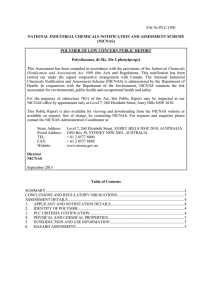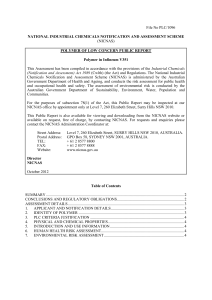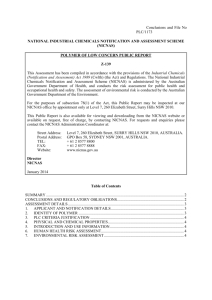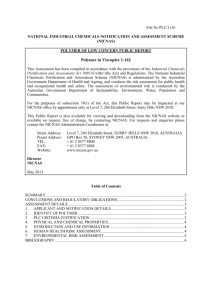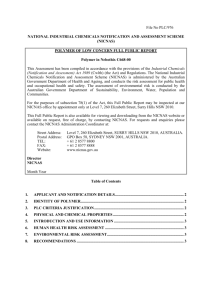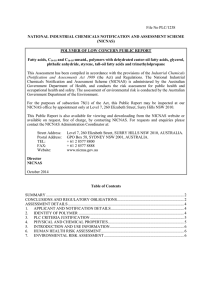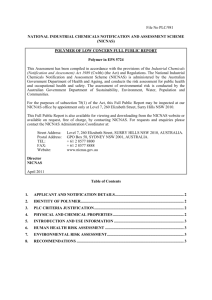PLC/1244
advertisement
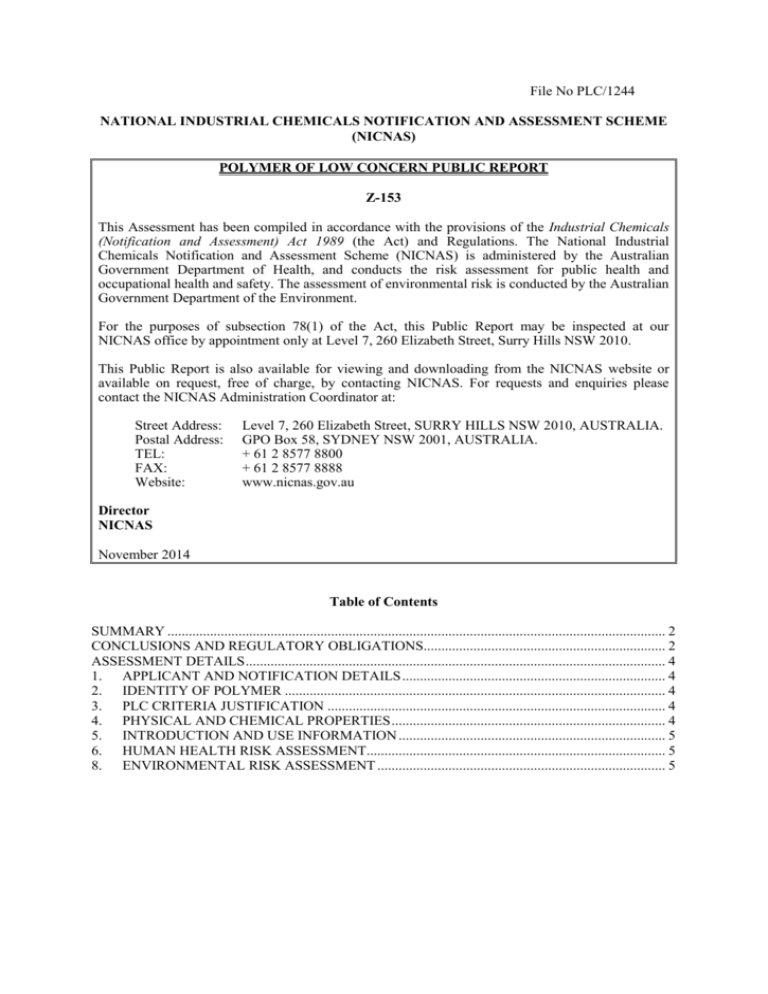
File No PLC/1244 NATIONAL INDUSTRIAL CHEMICALS NOTIFICATION AND ASSESSMENT SCHEME (NICNAS) POLYMER OF LOW CONCERN PUBLIC REPORT Z-153 This Assessment has been compiled in accordance with the provisions of the Industrial Chemicals (Notification and Assessment) Act 1989 (the Act) and Regulations. The National Industrial Chemicals Notification and Assessment Scheme (NICNAS) is administered by the Australian Government Department of Health, and conducts the risk assessment for public health and occupational health and safety. The assessment of environmental risk is conducted by the Australian Government Department of the Environment. For the purposes of subsection 78(1) of the Act, this Public Report may be inspected at our NICNAS office by appointment only at Level 7, 260 Elizabeth Street, Surry Hills NSW 2010. This Public Report is also available for viewing and downloading from the NICNAS website or available on request, free of charge, by contacting NICNAS. For requests and enquiries please contact the NICNAS Administration Coordinator at: Street Address: Postal Address: TEL: FAX: Website: Level 7, 260 Elizabeth Street, SURRY HILLS NSW 2010, AUSTRALIA. GPO Box 58, SYDNEY NSW 2001, AUSTRALIA. + 61 2 8577 8800 + 61 2 8577 8888 www.nicnas.gov.au Director NICNAS November 2014 Table of Contents SUMMARY ............................................................................................................................................ 2 CONCLUSIONS AND REGULATORY OBLIGATIONS.................................................................... 2 ASSESSMENT DETAILS ...................................................................................................................... 4 1. APPLICANT AND NOTIFICATION DETAILS .......................................................................... 4 2. IDENTITY OF POLYMER ........................................................................................................... 4 3. PLC CRITERIA JUSTIFICATION ............................................................................................... 4 4. PHYSICAL AND CHEMICAL PROPERTIES ............................................................................. 4 5. INTRODUCTION AND USE INFORMATION ........................................................................... 5 6. HUMAN HEALTH RISK ASSESSMENT.................................................................................... 5 8. ENVIRONMENTAL RISK ASSESSMENT ................................................................................. 5 November 2014 NICNAS SUMMARY The following details will be published in the NICNAS Chemical Gazette: ASSESSMENT APPLICANT(S) REFERENCE PLC/1244 CHEMICAL OR HAZARDOUS INTRODUCTION TRADE NAME SUBSTANCE VOLUME Z-153 No ≤ 15 tonnes per annum Lubrizol International, Inc. USE Component of personal cleansing products CONCLUSIONS AND REGULATORY OBLIGATIONS Human Health Risk Assessment Based on the assumed low hazard and the assessed use pattern, the notified polymer is not considered to pose an unreasonable risk to the health of workers and the public. Environmental Risk Assessment Based on the assumed low hazard and the assessed use pattern, the notified polymer is not considered to pose an unreasonable risk to the environment. Health and Safety Recommendations No specific engineering controls, work practices or personal protective equipment are required for the safe use of the notified polymer itself. However, these should be selected on the basis of all ingredients in the formulation. Guidance in selection of personal protective equipment can be obtained from Australian, Australian/New Zealand or other approved standards. A copy of the (M)SDS should be easily accessible to employees. If products and mixtures containing the notified polymer are classified as hazardous to health in accordance with the Globally Harmonised System for the Classification and Labelling of Chemicals (GHS), as adopted for industrial chemicals in Australia, workplace practices and control procedures consistent with provisions of State and Territory hazardous substances legislation should be in operation. Disposal Where reuse or recycling are not appropriate, dispose of the notified chemical in an environmentally sound manner in accordance with relevant Commonwealth, state, territory and local government legislation. Emergency Procedures Spills and/or accidental release of the notified polymer should be handled by physical containment, collection and subsequent safe disposal. Secondary Notification This risk assessment is based on the information available at the time of notification. The Director may call for the reassessment of the polymer under secondary notification provisions based on changes in certain circumstances. Under Section 64 of the Industrial Chemicals (Notification and Assessment) Act (1989) the notifier, as well as any other importer or manufacturer of the notified polymer, have post-assessment regulatory obligations to notify NICNAS when any of these FULL PUBLIC REPORT: PLC/1244 Page 2 of 5 November 2014 NICNAS circumstances change. These obligations apply even when the notified polymer is listed on the Australian Inventory of Chemical Substances (AICS). Therefore, the Director of NICNAS must be notified in writing within 28 days by the notifier, other importer or manufacturer: (1) Under Section 64(1) of the Act; if the notified polymer is introduced in a chemical form that does not meet the PLC criteria. or (2) Under Section 64(2) of the Act; if the function or use of the notified polymer has changed from component of personal cleaning agents, or is likely to change significantly; the amount of notified polymer being introduced has increased, or is likely to increase, significantly; the notified polymer has begun to be manufactured in Australia; additional information has become available to the person as to an adverse effect of the notified polymer on occupational health and safety, public health, or the environment. The Director will then decide whether a reassessment (i.e. a secondary notification and assessment) is required. (Material) Safety Data Sheet The (M)SDS of products containing the notified polymer was provided by the applicant. The accuracy of the information on the (M)SDS remains the responsibility of the applicant. PUBLIC REPORT: PLC/1244 Page 3 of 5 November 2014 NICNAS ASSESSMENT DETAILS 1. APPLICANT AND NOTIFICATION DETAILS Applicants Lubrizol International, Inc. (ABN: 52 073 495 603) 28 River Street SILVERWATER NSW 2128 Exempt Information (Section 75 of the Act) Data items and details claimed exempt from publication: chemical name, CAS number, structural formulae, molecular weight, polymer constituents, residual monomers/impurities and import volume 2. IDENTITY OF POLYMER Marketing Name(s) Z-153 Other Name(s) EX-1200 4800-1702,1 4800,126 Molecular Weight Number Average Molecular Weight (Mn) is > 10,000 Da 3. PLC CRITERIA JUSTIFICATION Criterion Molecular Weight Requirements Functional Group Equivalent Weight (FGEW) Requirements Low Charge Density Approved Elements Only Stable Under Normal Conditions of Use Not Water Absorbing Not a Hazard Substance or Dangerous Good Criterion met Yes Yes Yes Yes Yes Yes Yes The notified polymer meets the PLC criteria. 4. PHYSICAL AND CHEMICAL PROPERTIES Appearance at 20 °C and 101.3 kPa Melting Point/Glass Transition Temp Density Water Solubility Particle Size Reactivity Degradation Products White solid Not determined (manufactured in water) 1020 kg/m3 at 25 °C (70% polymer in water) Miscible in water Not determined (manufactured in water) Stable under normal environmental conditions None under normal conditions of use 5. INTRODUCTION AND USE INFORMATION Maximum Introduction Volume of Notified Chemical (100%) Over Next 5 Years Year 1 PUBLIC REPORT: PLC/1244 2 3 4 5 Page 4 of 5 November 2014 Tonnes NICNAS 5-10 5-10 5-10 10-15 10-15 Use The notified polymer will be imported into Australia in water at 70% concentration and will be used at a concentration of 1.5-2.5% in personal cleansing products (body wash, hand wash, face wash and soap). 6. HUMAN HEALTH RISK ASSESSMENT No toxicological data were submitted. The notified polymer meets the PLC criteria and is therefore assumed to be of low hazard. The risk of the notified polymer to occupational and public health is not considered to be unreasonable given the assumed low hazard and the assessed use pattern. 7. ENVIRONMENTAL RISK ASSESSMENT No ecotoxicological data were submitted. Polymers without significant ionic functionality are generally of low concern to the environment. The majority of the notified polymer will be released to sewer as a result of its use in skin care products. Release is assumed to occur daily, and to be diffuse in nature. A predicted environmental concentration in rivers (PECriver) can be calculated on the assumptions that 100% of the total annual import volume is released to sewer nationwide but that 90% of the notified polymer is removed by sewage treatment plant (STP) processes. The PECriver is 0.91 μg/L if the daily chemical release (15000 kg/365 = 41.1 kg) is diluted by the daily effluent production (200 L/person/day × 22.613 million people = 4,523 ML). The remainder of the notified polymer partitions to biosolids with an estimated concentration of 81.8 mg/kg (dry wt), and is expected to be disposed of to landfill or applied to agricultural soils for soil remediation. Notified polymer released to surface waters is not expected to reach ecotoxicologically significant concentrations. When applied to agricultural soils in biosolids or disposed of to landfill, the notified polymer is expected to associate with soil and organic matter and be largely immobile. The notified polymer is not expected to cross biological membranes due to its high molecular weight and is therefore not expected to bioaccumulate. The notified polymer is expected to eventually degrade to form water and oxides of carbon. Therefore, based on its assumed low hazard and assessed use pattern, the notified polymer is not considered to pose an unreasonable risk to the environment. BIBLIOGRAPHY Boethling RS & Nabholz JV (1997) Environmental Assessment of Polymers under the U.S. Toxic Substances Control Act. In: Hamilton JD & Sutcliffe R, ed. Ecological Assessment of Polymers; Strategies for product stewardship and regulatory programs. New York, Van Nostrand Reinhold, pp 187–234. PUBLIC REPORT: PLC/1244 Page 5 of 5
